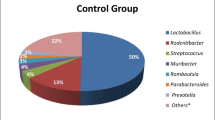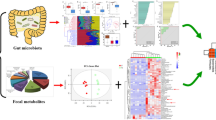Abstract
Intestinal nutrition has a close association with the onset and development of fluorosis. Intestinal microbes play a major role in intestinal nutrition. However, the effect of fluoride on intestinal microbes is still not fully understood. This study aimed to evaluate the dose-response of fluoride on fecal microbes as well as the link between fluorosis and fecal microbes. The results showed that fluoride did not significantly alter the diversity of fecal microbiota, but richness estimators (ACE and Chao) increased first, and then decreased with the increase of water fluoride. At the genus level, 150 mg/L fluoride significantly reduced the abundances of Roseburia and Clostridium sensu stricto, and 100 mg/L and 150 mg/L fluoride obviously increased the abundances of Unclassified Ruminococcaceaes and Unclassified Bdellovibrionales, respectively. The correlation analysis showed fluoride exposure had a negative association with Roseburia and Turicibacter and was positively associated with Pelagibacterium, Unclassified Ruminococcaceae, and Unclassified Bdellovibrionales. Dental fluorosis was negatively associated with Clostridium sensu stricto, Roseburia, Turicibacter, and Paenalcaligenes and had a positive association with Pelagibacterium, Unclassified Ruminococcaceae, and Unclassified Bdellovibrionales. In conclusion, this study firstly reports fluoride in drinking water has a remarkable biphasic effect on fecal microbiota in rats, and some bacteria are significantly associated with fluoride exposure and dental fluorosis. These results indicate the gut microbiota may play an important role in fluorosis, and some bacteria are likely to be developed as biomarkers for fluorosis.


Similar content being viewed by others
Data Availability
The datasets used and/or analyzed during the current study are available from the corresponding author on reasonable request.
References
Sun D (2011) Endemiology. People’s Medical Publishing House, Beijing
Petrone P, Giordano M, Giustino S, Guarino FM (2011) Enduring fluoride health hazard for the Vesuvius area population: the case of AD 79 Herculaneum. PLoS One 6(6):e21085. https://doi.org/10.1371/journal.pone.0021085
Patil MM, Lakhkar BB, Patil SS (2018) Curse of fluorosis. Indian J Pediatr 85(5):375–383. https://doi.org/10.1007/s12098-017-2574-z
Abanto Alvarez J, Rezende KM, Marocho SM, Alves FB, Celiberti P, Ciamponi AL (2009) Dental fluorosis: exposure, prevention and management. Med Oral Patol Oral Cir Bucal 14(2):E103–E107
Patel PP, Patel PA, Zulf MM, Yagnik B, Kajale N, Mandlik R, Khadilkar V, Chiplonkar SA, Phanse S, Patwardhan V, Joshi P, Patel A, Khadilkar AV (2017) Association of dental and skeletal fluorosis with calcium intake and serum vitamin D concentration in adolescents from a region endemic for fluorosis. Indian J Endocrinol Metab 21(1):190–195. https://doi.org/10.4103/2230-8210.196013
Liu G, Ye Q, Chen W, Zhao Z, Li L, Lin P (2015) Study of the relationship between the lifestyle of residents residing in fluorosis endemic areas and adult skeletal fluorosis. Environ Toxicol Pharmacol 40(1):326–332. https://doi.org/10.1016/j.etap.2015.06.022
Davila AM, Blachier F, Gotteland M, Andriamihaja M, Benetti PH, Sanz Y, Tome D (2013) Intestinal luminal nitrogen metabolism: role of the gut microbiota and consequences for the host. Pharmacol Res 68(1):95–107. https://doi.org/10.1016/j.phrs.2012.11.005
Skrypnik K, Suliburska J (2018) Association between the gut microbiota and mineral metabolism. J Sci Food Agric 98(7):2449–2460. https://doi.org/10.1002/jsfa.8724
Kashyap PC, Chia N, Nelson H, Segal E, Elinav E (2017) Microbiome at the frontier of personalized medicine. Mayo Clin Proc 92(12):1855–1864. https://doi.org/10.1016/j.mayocp.2017.10.004
Claesson MJ, Clooney AG, O’Toole PW (2017) A clinician’s guide to microbiome analysis. Nat Rev Gastroenterol Hepatol 14(10):585–595. https://doi.org/10.1038/nrgastro.2017.97
Meng Y (2013) Preliminary studies on inducing effect of fluoride on micro-dysbiosis of intestinal microecosystem in mice. Shanxi Agricultural University
Guannan L, Xuejuan X, Sendegeya P, Huanhuan Z, Yaohang L, Yong Z (2015) Effect of fluoride on gut microflora of silkworm. Acta Microbiologica Sinica 55(7):926–934
Luo Q, Cui H, Peng X, Fang J, Zuo Z, Deng J, Liu J, Deng Y (2016) Dietary high fluorine alters intestinal microbiota in broiler chickens. Biol Trace Elem Res 173(2):483–491. https://doi.org/10.1007/s12011-016-0672-9
Liu J, Wang HW, Lin L, Miao CY, Zhang Y, Zhou BH (2019) Intestinal barrier damage involved in intestinal microflora changes in fluoride-induced mice. Chemosphere 234:409–418. https://doi.org/10.1016/j.chemosphere.2019.06.080
Fu R, Niu R, Li R, Yue B, Zhang X, Cao Q, Wang J, Sun Z (2019) Fluoride-induced alteration in the diversity and composition of bacterial microbiota in mice colon. Biol Trace Elem Res. 196:537–544. https://doi.org/10.1007/s12011-019-01942-w
Yasuda K, Hsu T, Gallini CA, McLver LJ, Schwager E, Shi A, DuLong CR, Schwager RN, Abu-Ali GS, Franzosa EA, Garrett WS, Huttenhower C, Morgan XC (2017) Fluoride depletes acidogenic taxa in oral but not gut microbial communities in mice. mSystems 2 (4). https://doi.org/10.1128/mSystems.00047-17
Wu H (2019) Study on the characteristics of gut microbiota for children with dental fluorosis in drinking water-born endemic fluorosis areas. Zhengzhou University
Wang HW, Miao CY, Liu J, Zhang Y, Zhu SQ, Zhou BH (2020) Fluoride-induced rectal barrier damage and microflora disorder in mice. Environ Sci Pollut Res Int 27(7):7596–7607. https://doi.org/10.1007/s11356-019-07201-8
Nguyen TL, Vieira-Silva S, Liston A, Raes J (2015) How informative is the mouse for human gut microbiota research? Dis Model Mech 8(1):1–16. https://doi.org/10.1242/dmm.017400
Yao Y, Ma Y, Zhong N, Pei J (2019) The inverted U-curve association of fluoride and osteoclast formation in mice. Biol Trace Elem Res 191(2):419–425. https://doi.org/10.1007/s12011-018-1624-3
Cheng C, Sun J, Zheng F, Wu K, Rui Y (2014) Molecular identification of clinical “difficult-to-identify” microbes from sequencing 16S ribosomal DNA and internal transcribed spacer 2. Ann Clin Microbiol Antimicrob 13:1. https://doi.org/10.1186/1476-0711-13-1
Den Besten PK (1994) Dental fluorosis: its use as a biomarker. Adv Dent Res 8(1):105–110. https://doi.org/10.1177/08959374940080010201
Wang W, Cao J, Li JR, Yang F, Li Z, Li LX (2016) Comparative analysis of the gastrointestinal microbial communities of bar-headed goose (Anser indicus) in different breeding patterns by high-throughput sequencing. Microbiol Res 182:59–67. https://doi.org/10.1016/j.micres.2015.10.003
Wang L, Wang LA, Zhan X, Huang Y, Wang J, Wang X (2020) Response mechanism of microbial community to the environmental stress caused by the different mercury concentration in soils. Ecotoxicol Environ Saf 188:109906. https://doi.org/10.1016/j.ecoenv.2019.109906
Tomova A, Bukovsky I, Rembert E, Yonas W, Alwarith J, Barnard ND, Kahleova H (2019) The effects of vegetarian and vegan diets on gut microbiota. Front Nutr 6:47. https://doi.org/10.3389/fnut.2019.00047
Sagheddu V, Patrone V, Miragoli F, Puglisi E, Morelli L (2016) Infant early gut colonization by Lachnospiraceae: high frequency of Ruminococcus gnavus. Front Pediatr 4:57. https://doi.org/10.3389/fped.2016.00057
Xie H (2017) A comparative study of intestinal flora and its metabolites short chain fatty acid and injury markers of intestinal mucosal in HIV infected and healthy subjects. Southwest Medical University,
Dashiff A, Junka RA, Libera M, Kadouri DE (2011) Predation of human pathogens by the predatory bacteria Micavibrio aeruginosavorus and Bdellovibrio bacteriovorus. J Appl Microbiol 110(2):431–444. https://doi.org/10.1111/j.1365-2672.2010.04900.x
Kasahara K, Krautkramer KA, Org E, Romano KA, Kerby RL, Vivas EI, Mehrabian M, Denu JM, Bäckhed F, Lusis AJ, Rey FE (2018) Interactions between Roseburia intestinalis and diet modulate atherogenesis in a murine model. Nat Microbiol 3(12):1461–1471. https://doi.org/10.1038/s41564-018-0272-x
La Rosa SL, Leth ML, Michalak L, Hansen ME, Pudlo NA, Glowacki R, Pereira G, Workman CT, Arntzen M, Pope PB, Martens EC, Hachem MA, Westereng B (2019) The human gut Firmicute Roseburia intestinalis is a primary degrader of dietary β-mannans. Nat Commun 10(1):905. https://doi.org/10.1038/s41467-019-08812-y
Jia L, Li D, Feng N, Shamoon M, Sun Z, Ding L, Zhang H, Chen W, Sun J, Chen YQ (2017) Anti-diabetic effects of Clostridium butyricum CGMCC0313.1 through promoting the growth of gut butyrate-producing bacteria in type 2 diabetic mice. Sci Rep 7(1):7046. https://doi.org/10.1038/s41598-017-07335-0
Trinidad TP, Wolever TM, Thompson LU (1999) Effects of calcium concentration, acetate, and propionate on calcium absorption in the human distal colon. Nutrition 15(7-8):529–533. https://doi.org/10.1016/s0899-9007(99)00110-0
St-Pierre B, Wright AG (2017) Implications from distinct sulfate-reducing bacteria populations between cattle manure and digestate in the elucidation of H(2)S production during anaerobic digestion of animal slurry. Appl Microbiol Biotechnol 101(13):5543–5556. https://doi.org/10.1007/s00253-017-8261-1
Zhang-Sun W, Augusto LA, Zhao L, Caroff M (2015) Desulfovibrio desulfuricans isolates from the gut of a single individual: structural and biological lipid A characterization. FEBS Lett 589(1):165–171. https://doi.org/10.1016/j.febslet.2014.11.042
Reddy GS, Srikantia SG (1971) Effect of dietary calcium, vitamin C and protein in development of experimental skeletal fluorosis. I. Growth, serum chemistry, and changes in composition, and radiological appearance of bones. Metabolism 20(7):642–656. https://doi.org/10.1016/0026-0495(71)90077-1
Jowsey J, Riggs BL (1978) Effect of concurrent calcium ingestion on intestinal absorption of fluoride. Metabolism 27(8):971–974. https://doi.org/10.1016/0026-0495(78)90141-5
Cerklewski FL, Ridlington JW (1987) Influence of type and level of dietary calcium on fluoride bioavailability in the rat. Nutrition Research 7(10):1073–1083
Wang HW, Liu J, Zhao WP, Zhang ZH, Li SQ, Li SH, Zhu SQ, Zhou BH (2019) Effect of fluoride on small intestine morphology and serum cytokine contents in rats. Biol Trace Elem Res 189(2):511–518. https://doi.org/10.1007/s12011-018-1503-y
Segata N, Izard J, Waldron L, Gevers D, Miropolsky L, Garrett WS, Huttenhower C (2011) Metagenomic biomarker discovery and explanation. Genome Biol 12(6):R60. https://doi.org/10.1186/gb-2011-12-6-r60
Funding
This study was supported by the National Natural Science Foundation of China (81773468 and 81302389), the Wu Liande Science Foundation of Harbin Medical University (Grant No. WLD-QN1703), and the Postdoctoral Scientific Research Developmental Fund of Heilongjiang Province (LBH-Q17092).
Author information
Authors and Affiliations
Contributions
Conceived and designed the experiments: Junrui Pei
Raised the animals: Liaowei Wu and Wei Huang
Performed the experiments: Nan Zhong, Yongzheng Ma, Xinyue Meng, and Junrui Pei
Contributed reagents/materials/analysis tools: Junrui Pei and Yanhui Gao
Wrote the paper: Junrui Pei, Nan Zhong, Yongzheng Ma, Xinyue Meng, and Alphonse Sowanou
Corresponding author
Ethics declarations
Conflict of Interest
The authors declare no competing interests.
Additional information
Publisher’s Note
Springer Nature remains neutral with regard to jurisdictional claims in published maps and institutional affiliations.
Supplementary Information
ESM 1
(DOCX 6318 kb)
Rights and permissions
About this article
Cite this article
Zhong, N., Ma, Y., Meng, X. et al. Effect of Fluoride in Drinking Water on Fecal Microbial Community in Rats. Biol Trace Elem Res 200, 238–246 (2022). https://doi.org/10.1007/s12011-021-02617-1
Received:
Accepted:
Published:
Issue Date:
DOI: https://doi.org/10.1007/s12011-021-02617-1




